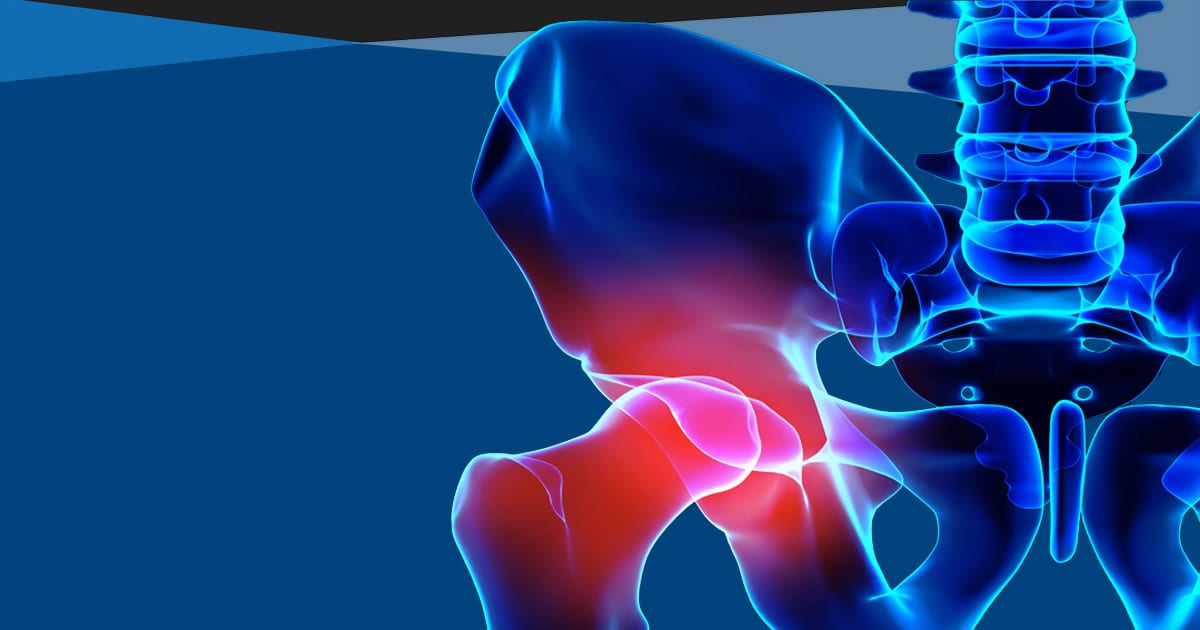Understanding Hip Pain

Today, people are living longer, more active lives. With increased activity, however, comes hip pain from the extra wear and tear on the largest joint in the body.
In today’s post, Dr. Jeffrey J. Sketchler explains the anatomy of the hip, the most common causes of hip pain, and the latest treatment options.
The anatomy of the hip
The hip is the largest ball and socket joint in the body made up of the thigh bone (femur), femoral head, acetabulum, tendons, ligaments, and cartilage. Not only does this complex joint support the weight of the upper body, it also controls the movement of the upper leg:
The cartilage that covers the femoral head is kept slippery with synovial fluid. These two components keep the bones moving against each other without pain. The ligaments and tendons around the joint keep the bones from dislocating. Hip pain happens when there is an injury, trauma, or disease that impacts these complex, moving parts.
Common causes of hip pain
Due to the amount of movement and stress on the hip joint, it is important that the cartilage remains healthy and the joint stays in overall good condition. Dr. Sketchler says the majority of hip cases he sees can be attributed to worn cartilage, inflammation, or injury.
Arthritis
Rheumatoid arthritis and osteoarthritis are degenerative joint diseases. Because of chronic inflammation, the cartilage in the hip wears down, making it painful to move the joint. In osteoarthritis of the hip, the pain is experienced in the groin, gets worse with weight bearing activities, and makes it difficult to rotate the leg. Learn more about osteoarthritis...
Bursitis
If you have bursitis, you’ll feel the pain directly in your hip. The bursa, or fluid-filled pads that cushion the joints can become inflamed and friction will occur when the joint moves. This condition rarely needs surgery and is often effectively alleviated with non-surgical treatments. Hip bursitis is more common in women, middle-aged, and elderly people, according to the American Academy of Orthopedic Surgeons. Learn more about bursitits...
Referred Pain
Referred pain from the lower back is generally caused from sciatica. When the sciatic nerve is injured or has pressure put on it, it can cause pain. This pain is usually felt in the buttocks and can sometimes radiate into the thigh.
Avascular Necrosis
This rare condition is the cause of about 5% of hip cases, says Dr. Sketchler. Avascular necrosis is a result of long term steroid use or heavy drinking. These behaviors can cause part of the hip bone or femoral head to deteriorate or collapse, requiring replacement.
Treatment Options for Hip Pain
Pain that interferes with normal, daily activities and lasts longer than two weeks should be evaluated by an orthopedic specialist. Following a proper diagnosis, there are several treatment options available. Dr. Sketchler says that whenever possible, he tries to treat hip cases nonsurgically. The first step typically involves anti-inflammatory medication, rest, and ice. Stretching exercises have also proven helpful with minor hip discomfort.
“Pain that interferes with normal, daily activities and lasts longer than two weeks should be evaluated by an orthopedic specialist.”
- Jeffrey J. Sketchler, MD
Treatment options
Ultrasound guided injections
Ultrasound guided injections target exact pain points. These injections often consist of cortisone (a steroid), hyaluronic acid (a joint lubricant), and a local anesthetic. This outpatient procedure takes about 10-15 minutes and has proven especially effective in treating pain from bursitis and sciatica. Learn more about ultrasound guided injections...
Physical therapy
In many cases, physical therapy is ordered before, during, and after other treatments to ensure the best possible outcome. Physical therapy starts with an assessment and treatment plan to create exercises and stretching tailored for your specific hip condition. Exercises that build up muscles supporting the hip will place less stress on it and increase flexibility--both of which can reduce pain. Learn more about physical therapy...
Hip replacement
“If nonsurgical treatments aren’t effective, joint replacement is typically a very successful surgery,” says Dr. Sketchler. In joint replacement, the damaged cartilage and bone are replaced with a prosthetic component. Because of technological advancements, some hip surgeries can be outpatient procedures. Others may entail a one or two night hospital stay. Recovery usually takes around six weeks.
Is it really your hip?
The cause pain can be difficult to diagnose on your own. That’s why it’s important to get an accurate diagnosis. Sometimes the pain originates elsewhere in your body.
Dr. Sketchler says that patients can confuse pain at the hip joint that’s actually coming from the back or other areas. For example, conditions like endometriosis and sciatica can cause pain in the hip area. An accurate diagnosis by a specialist will ensure that the direct cause of your pain is being effectively treated.
Preventing Hip Pain
To preserve your hip health, stay active longer, and avoid surgery, the best advice is to stay in shape. Dr. Sketchler says, “obesity is a huge factor in developing arthritis in any weight-bearing joint, like your hip.” Maintaining a well-balanced diet and exercising are important, not just for your overall health, but for your joint health as well.
“ Obesity is a huge factor in developing arthritis in any weight-bearing joint, like your hip.”
- Jeffrey J. Sketchler, MD
Why see an orthopedist for your hip
An early, accurate diagnosis is your best chance to potentially slow down the progression of the condition. If your hip pain lasts longer than two weeks or keeps you from doing everyday tasks, contact Pontchartrain Orthopedic and Sports Medicine for an evaluation. Remember, you’re living longer and you’re more active--it’s more important than ever to take care of your hips.
About the Doctor
 New Orleans native Jeffrey J. Sketchler, MD is a board certified orthopedic surgeon with over 25 years of experience in the surgical and non-surgical treatment of musculoskeletal and orthopedic conditions. He specializes in treating conditions that affect the hip and other large joints.
New Orleans native Jeffrey J. Sketchler, MD is a board certified orthopedic surgeon with over 25 years of experience in the surgical and non-surgical treatment of musculoskeletal and orthopedic conditions. He specializes in treating conditions that affect the hip and other large joints.
This website is not designed to and does not provide medical advice, medical diagnosis, professional opinion, treatment or services to you or any other person. Through this website and links to other websites, Pontchartrain Orthopedics & Sports Medicine provides general information for educational purposes only. The information provided in this website, or through links to other sites, is not a substitute for medical care. You should not use this information in place of a visit, call, consultation or the advice of your healthcare provider. Pontchartrain Orthopedics & Sports Medicine is not liable or responsible for any advice, course of treatment, diagnosis or any other information, services or product you obtain through this site.

